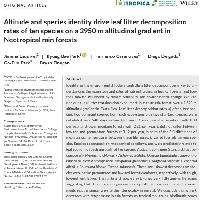Resumen
- Identifying the environmental factors controlling litter decomposition is key to understanding the magnitude and rates of nutrient cycling in tropical forests, and how they may be influenced by climate variability and environmental change. We carried out a leaf litter translocation experiment in mature rain forest over a 2,520 m altitudinal gradient in Costa Rica. Leaf litter decomposition rates (k) of ten tree species, two dominant species from each ecosystem, plus two standard species, were calculated over 540 days in four life zones. k was lowest in montane with 0.83 per year and lower montane forests with 2.21 per year. k did not differ between lowland and premontane forests at 3.12 per year, in spite of the 3℃ difference of mean annual temperature between these life zones. k varied fourfold among species. Species decomposition rates ranked as follows, and were predictably related to leaf economic spectrum traits of the species: Acalypha communis (standard, fast decomposer)» Hyeronima oblonga > Alchornea latifolia, Quercus bumelioides, Jarava ichu (standard, slow decomposer)> Minquartia guianensis > Magnolia sororum > Vochysia allenii > Pourouma bicolor, Carapa guianensis. These two slowest‐decomposing species were native premontane and lowland forest dominants, respectively, with tough, low‐nutrient leaves. The ranking of species by k varied very little among life zones suggesting that decomposer organisms in very different ecosystems and environments react in similar ways to the litter quality in general. We conclude that while k decreases with temperature in rain forests on tropical mountains, bioclimatic zones defined as premontane may be “functionally lowland.” The effects of species identity on decomposition rates on tropical mountains are consistent and independent of environment for both standard and native species. Under climate change on these mountains, if moisture regimes do not change, decomposition rates will increase due to rising temperatures. Soil carbon storage may therefore decrease. Changes in the altitudinal distributions of currently dominant species will also affect this critically important biogeochemical process.
